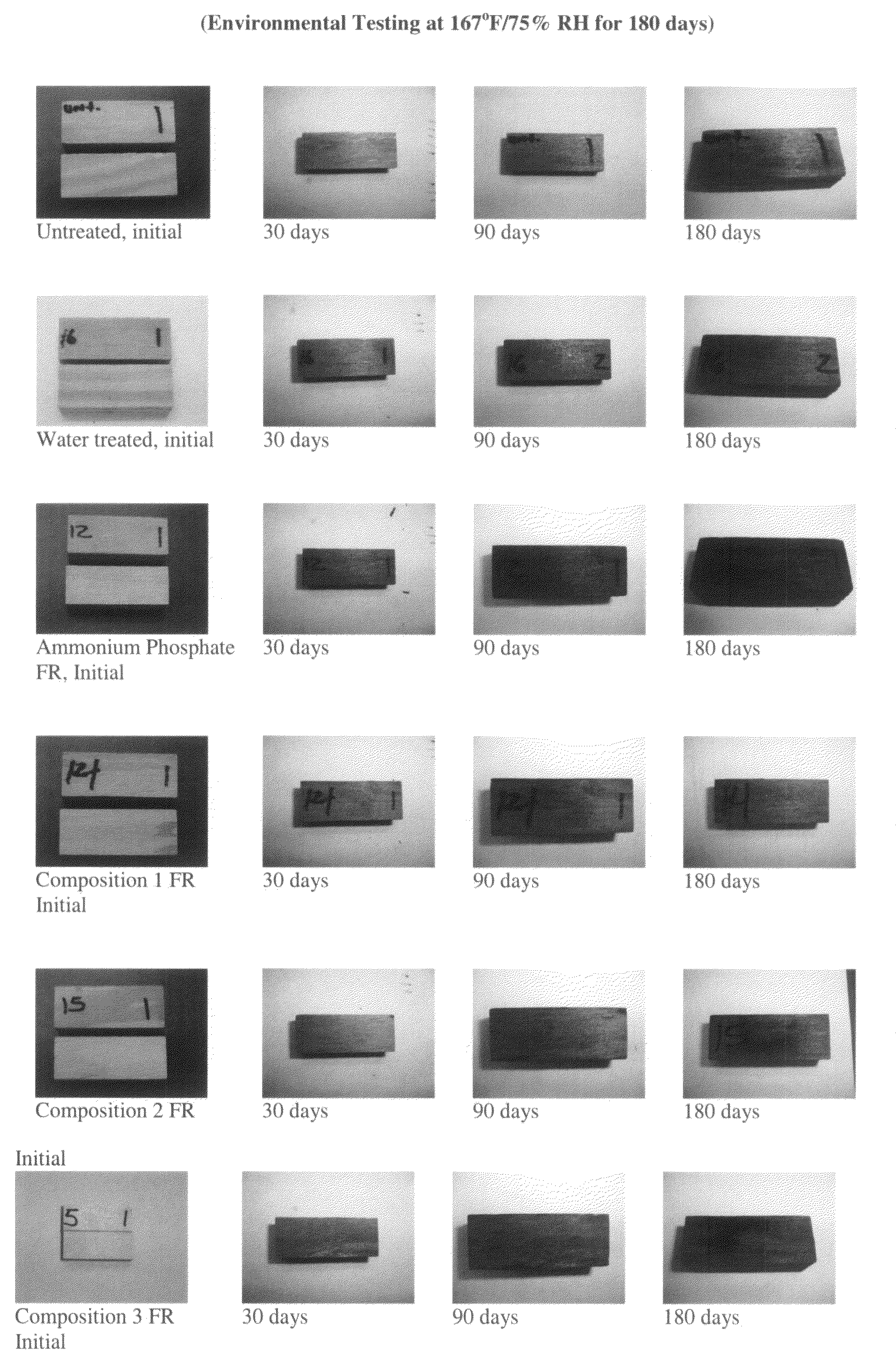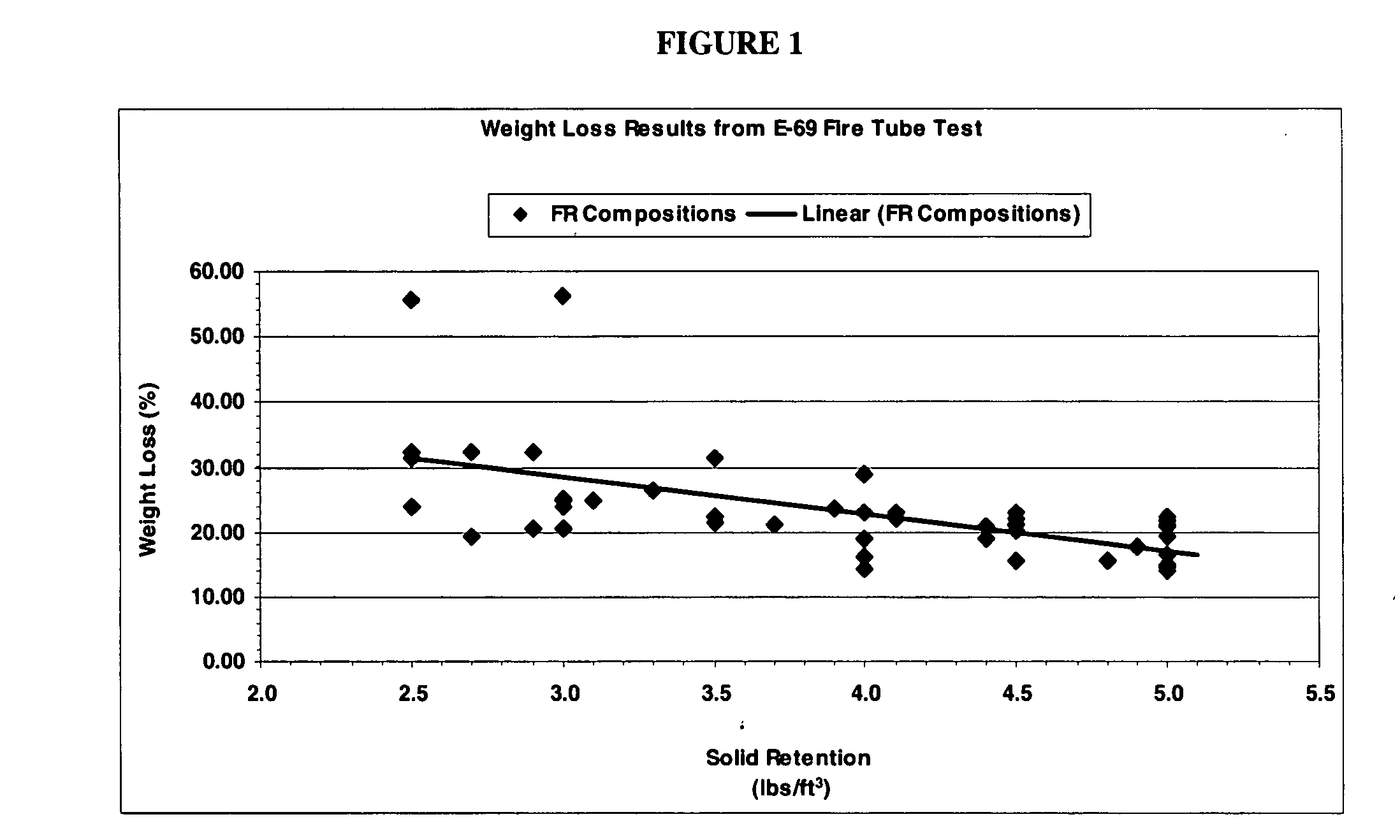Fire-retardant compositions and methods of making and using same
a composition and fire-retardant technology, applied in the field of fire-retardant compositions, can solve the problems of significant human injury and death, use of wood and wood products as construction materials, and property damage of dollars per year
- Summary
- Abstract
- Description
- Claims
- Application Information
AI Technical Summary
Benefits of technology
Problems solved by technology
Method used
Image
Examples
example 1
[0043]5.0% aqueous fire-retardant solution using commercially available guanidine phosphate was prepared. At room temperature, 3 part GP and 2 part boric acid was added to 95 part water. The GP was added first and stirred until completely dissolved, usually less than 15 minutes. After the GP goes into solution, the BA was added, stirred until dissolved. The resulting solution is a clear liquid with a pH of 7.56, measured with a Mettler-Toledo MP 220 pH meter at room temperature.
[0044]The solution was used to treat wood samples for fire tube testing. The samples were pressured treated in a vacuum to 22-25″ of Hg followed by the addition of the treating solution. The treatment chamber was then applied with pressure at 120 psi. The treated wood was dried until the moisture content reached between 4%-10%. The samples were subjected to ASTM E-69 fire tube test and the results are shown in table 1. The data show wood treated with the 5% solution of the fire-retardant composition has good ...
example 2
[0045]5% solution of the fire-retardant composition was prepared with 2.5 part GP, 2.5 part boric acid and 95 part water. The final solution has a pH of 6.94. The solution was prepared, the fire tube sticks treated, pH measurement taken, and samples dried according to Example 1. The results show that treated wood with the fire-retardant composition has good fire performance properties.
TABLE 2ActiveMax FireRetentionWeightTube Temp.After FlameChar HeightTreatment(lbs. / ft3)Loss (%)(° F.)(min / sec)(″)Untreated wood0>70.0>800>4 min.405% GP + BA Solution2.4932.445001:2029
example 3
[0046]7.5% solution of the fire-retardant composition was prepared with 5.25 part GP, 2.25 part boric acid and 92.5 part water. The final solution has a pH of 7.49. The solution was prepared, the fire tube sticks treated, pH measurement taken, and samples dried according to Example 1. The results show that treated wood with the fire-retardant composition has good fire performance properties.
TABLE 3ActiveMax FireRetentionWeightTube Temp.After FlameChar HeightTreatment(lbs. / ft3)Loss (%)(° F.)(min / sec)(″)Untreated wood0>70.0>800>4 min.407.5% GP + BA Solution3.0225.23480:4025
PUM
| Property | Measurement | Unit |
|---|---|---|
| tube temperature | aaaaa | aaaaa |
| combustion temperatures | aaaaa | aaaaa |
| temperature | aaaaa | aaaaa |
Abstract
Description
Claims
Application Information
 Login to View More
Login to View More - R&D
- Intellectual Property
- Life Sciences
- Materials
- Tech Scout
- Unparalleled Data Quality
- Higher Quality Content
- 60% Fewer Hallucinations
Browse by: Latest US Patents, China's latest patents, Technical Efficacy Thesaurus, Application Domain, Technology Topic, Popular Technical Reports.
© 2025 PatSnap. All rights reserved.Legal|Privacy policy|Modern Slavery Act Transparency Statement|Sitemap|About US| Contact US: help@patsnap.com



